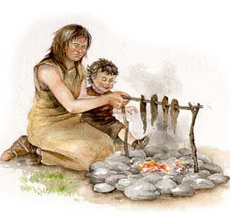FOOD 101: Cooking History
 Be grateful for your stove and microwave! Photo courtesy Sirgy.com. |
Do you like sashimi and steak tartare? Man has been wandering Earth for some 200,000 years, but the general use of fire began only about 40,000 to 50,000 years ago. Until then, man ate his food raw.* Neanderthals discovered how to deliberately create fire. This led to warmth—the priority in the Ice Age—and to the secondary benefit of cooking meats. Most likely, a piece of mammoth, venison or another flesh that would have been eaten raw, fell in the campfire. It had to be left there until the flames died down, no doubt filling the air with the alluring aroma of roasting meat. Heat breaks down tough fiber and releases flavor in the process. As a natural next step, meat and tough roots were slower cooked in the embers or on a flat stone by the side of the fire. |
|
|
Boiling took more time to evolve, using large mollusk or turtle shells until man created vessels of earthenware or bark that could be placed over the fire. Steaming inside animal stomachs and leaves preceded the more sophisticated development of crockery. The first oven could have been as simple as a hole in the ground. Here’s what your most ancient of forefathers did: The use of fire vastly extended man’s diet, enabling tough foods to be palatable. Cereals—barley, millet, rice, rye, and wheat, as well as potatoes, require cooking before they can be consumed by humans. The use of fire doubtless encouraged the domestication of these foods and the end of lives as hunter-gatherers, as man settled into farming communities. Thanks to FoodTimeline.org for inspiring this article. |
||


